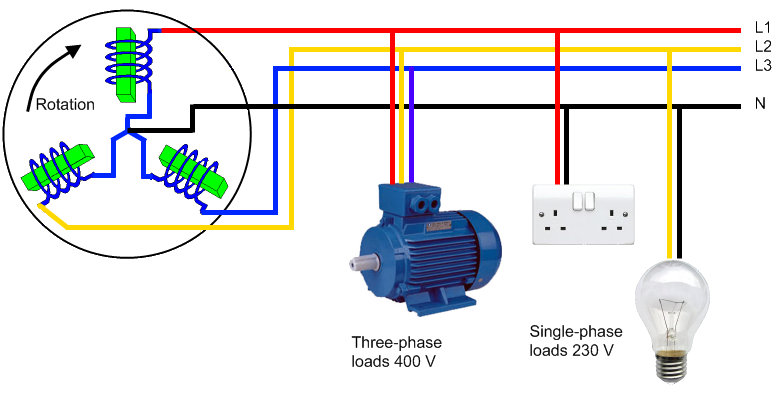Maximum Pv Power Can Connect To A 1000amp Single Pahes Electrical Service Panel?
Depending on where y'all live, your home may be fed by single-phase or iii-phase electrical connection. What relevance does this have for your solar PV installation?
3-phase and single-phase power
Both single-stage and 3-phase electricity are used to transmit and distribute electricity. Depending on where y'all live and how much electricity you consume, your home will exist fitted out with either a single-phase grid connection or a 3-phase solar filigree connection. (Virtually homes have single-phase connections.)
Regardless of whether you have a unmarried-phase or 3-phase connection, the appliances in your habitation all (almost certainly) run on a single phase. (3-phase ability is used to power motors in certain industrial applications, but not in homes.) In the case that y'all have a single-phase connection, electricity flows in and out of your dwelling house through a unmarried phase (imagine a single cablevision/circuit).
If you lot have a three-phase solar inverter connection, on the other hand, the electricity entering your home is divided into 3 split phases (imagine three cables/circuits). Unlike devices in your habitation volition be powered by these different phases. For example, your lights may run on one phase, while your washing machine and refrigerator may be on the other two phases.
The image beneath, from Prolux Electric, illustrates how 3-phase power is 'divided upward' for household & industrial loads. Y'all can see that all three phases feed into the industrial motor, while the lite earth and power point are each serviced past a unmarried phase (represented past the yellow and red lines, respectively).

Illustration of how 3-phase ability works on types of electrical loads. (Image via Prolux Electric.)
What the number of phases mean for your solar PV system?
If you don't accept a solar PV system, y'all may very well accept no idea if you lot're on a unmarried-stage or iii phase solar inverter connectedness. Regardless of which one y'all accept, the electricity you lot use is well-nigh probable beingness delivered seamlessly to all of your appliances – so information technology'south not really anything to be concerned virtually.
In the upshot that yous want to install a solar PV system, all the same, phases matter. For a unmarried-phase connection, a single-phase solar inverter should be installed – fairly straightforward.
For a 3-stage connection, on the other mitt, there are a number of options. In most cases the best and simplest option is to go a three-phase inverter, which will distribute the solar ability evenly beyond all three phases.
Some other option for a 3-phase connexion is to install one unmarried-phase inverter on one of the phases in the dwelling (preferably the one that uses the most electricity/has the heaviest loads). The downsides of this approach are that 1) if the solar system is as well big, the inverter could 'trip out' if the voltage for that phase goes to high, and ii) the solar free energy may not flow to the phase where it is needed nearly. For this reason, with this approach it'due south important to have your solar installer undertake an assessment to determine which phase is the all-time one – if y'all install on the incorrect phase, the energy that your solar system generates could end up going to waste product.
The 3rd selection is to install multiple (upwards to three) single-stage inverters, each ane on its own phase. This could prove to be a more expensive pick than only using a 3-phase solar inverter, however, and then it's important to consult with several solar installers to collect a variety of quotes and opinions before making a decision.
Solar system size considerations
It's also of import to bank check whether your phase connectedness volition have an impact on the size of solar system that you're allowed to install. Generally speaking, tighter solar organization size limits are placed on homes with single-phase connections than those with 3-stage connections.
In Southward Australia, for instance, solar PV system size is limited to 10kW in buildings serviced past single-phase connections, whereas homes and businesses with a three-phase connection may install systems as large as 30kW. Generally speaking, this is why a requirement for special approving from utilities for grid-connection of big solar PV systems in remote areas (which are sometimes serviced by 'single wire earth return' or SWER lines) is more than common than in areas with loftier population densities.
Air conditioning vs DC electricity explainer (simply in instance)
Air conditioning (alternating current) electricity. AC electricity is what most household electric appliances crave to operate. The other type of electricity, DC (directly current), is what solar panels and batteries produce. DC electricity is converted to usable AC electricity through a device called an inverter. AC current is distinguished from DC current primarily past the fact that its direction 'switches' back and forth rapidly, whereas DC is uni-directional. Without getting into the technical details as to why, this holding makes AC electricity more suitable for long-altitude manual.
Compare solar installation quotes instantly: Complete our Solar Quote Comparison request grade on the right of this folio.
© 2016 Solar Selection Pty Ltd
Top image via Wikipedia
Maximum Pv Power Can Connect To A 1000amp Single Pahes Electrical Service Panel?,
Source: https://www.solarchoice.net.au/blog/solar-power-single-phase-vs-3-phase-connections/
Posted by: loofas1938.blogspot.com


0 Response to "Maximum Pv Power Can Connect To A 1000amp Single Pahes Electrical Service Panel?"
Post a Comment